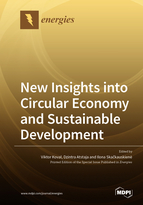New Insights into Circular Economy and Sustainable Development
A special issue of Energies (ISSN 1996-1073). This special issue belongs to the section "C: Energy Economics and Policy".
Deadline for manuscript submissions: closed (15 November 2022) | Viewed by 38376
Special Issue Editors
Interests: circular economy; green energy systems; sustainable development; rational use of nature resources; environmental economics
Interests: green economy; circular economy; design on sustainability; business control systems and management
Special Issues, Collections and Topics in MDPI journals
Special Issue Information
Dear Colleagues,
This Special Issue is focused on the wide-ranging topic of “New Insights into Circular Economy and Sustainable Development” and related to the implementation of the Green Deal Strategies in sectors of the economy and raw materials to ensure clean energy, sustainable industry, construction and renovation, sustainable mobility, pollution reduction, and climate action. This Special Issue covers a wide range of topical issues of sustainable natural resources management, circular economy, environmental management, and renewable energy. More specifically, the Special Issue will cover all the major and minor topics which help to find solutions for circular the economy and sustainable development problems, such as climate protection, sustainable natural resources management, regulation on sustainable investments, energy economics, environmental economics, environmental management, inclusive nature of green transition, renewable energy, smart energy materials sustainability and development, knowledge economy, and management and financing of the green transition. Manuscripts on interdisciplinary research are especially welcome.
Prof. Dr. Viktor Koval
Prof. Dr. Dzintra Atstaja
Prof. Dr. Ilona Skačkauskienė
Guest Editors
Manuscript Submission Information
Manuscripts should be submitted online at www.mdpi.com by registering and logging in to this website. Once you are registered, click here to go to the submission form. Manuscripts can be submitted until the deadline. All submissions that pass pre-check are peer-reviewed. Accepted papers will be published continuously in the journal (as soon as accepted) and will be listed together on the special issue website. Research articles, review articles as well as short communications are invited. For planned papers, a title and short abstract (about 100 words) can be sent to the Editorial Office for announcement on this website.
Submitted manuscripts should not have been published previously, nor be under consideration for publication elsewhere (except conference proceedings papers). All manuscripts are thoroughly refereed through a single-blind peer-review process. A guide for authors and other relevant information for submission of manuscripts is available on the Instructions for Authors page. Energies is an international peer-reviewed open access semimonthly journal published by MDPI.
Please visit the Instructions for Authors page before submitting a manuscript. The Article Processing Charge (APC) for publication in this open access journal is 2600 CHF (Swiss Francs). Submitted papers should be well formatted and use good English. Authors may use MDPI's English editing service prior to publication or during author revisions.
Keywords
- circular economy business models
- environmental economics and corporate social responsibility
- environmental management
- green human resource management
- inclusive nature of green transition
- knowledge economy
- management and financing the green transition
- rational use of nature resources
- regulation on sustainable investments
- renewable energy
- sustainable finance and circular economy
- sustainable natural resources management







